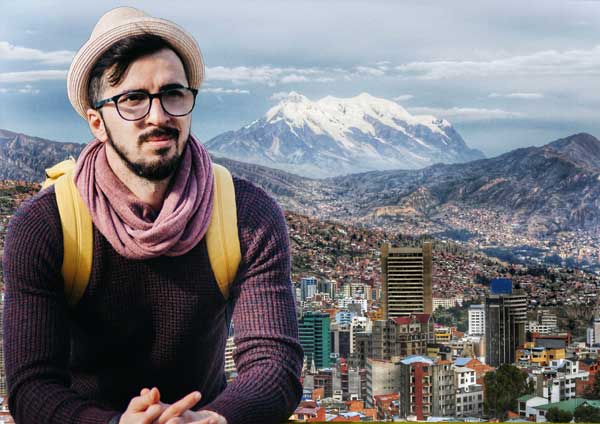
What can I do? Things to do in La Paz?
It is one of the usual questions that we all ask when arriving in a place unknown to us, or we know few places to visit.
Bolivia has a wide variety of things you can enjoy, such as culture, traditional food, tourist destinations, museums, historical places, and above all its high mountains that are present at all times.
Next we show you some of the things you can enjoy during your visit to La Paz Bolivia. Among the various things you can do and enjoy, we present the following:
Gastronomy
– in traditional food –
Salteña Juicy pie
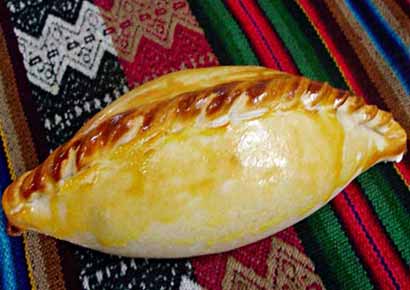
Salteña Juicy pie, baked and stuffed with hard-boiled egg, small pieces of potatoes, olives, spices and different types of meat; there are also vegetarian ones. It is one of the most consumed foods in La Paz at midmorning.
Chola Sandwich
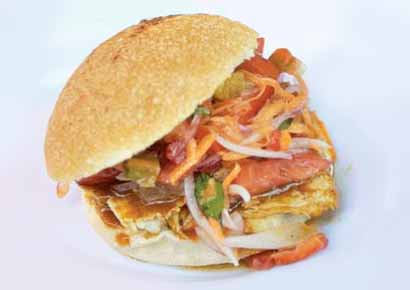 Chola sándwich, in its beginnings was prepared and sold by ladies of pollera. Its preparation includes traditional marraqueta bread, pork, escabeche, llajua or ají and cuerito o chicharrón de cerdo, ingredients that delight the palate of all those who visit the city of La Paz.
Chola sándwich, in its beginnings was prepared and sold by ladies of pollera. Its preparation includes traditional marraqueta bread, pork, escabeche, llajua or ají and cuerito o chicharrón de cerdo, ingredients that delight the palate of all those who visit the city of La Paz.
Plato Paceño
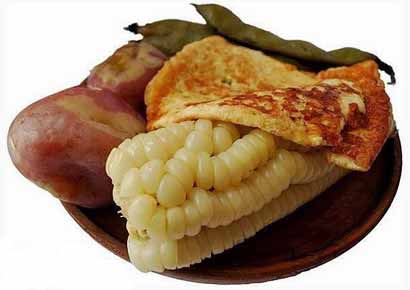 Plato Paceño It’s the dish that represents the city. It was born in 1781, in the so called “Cerco a La Paz”, in which thousands of indigenous people revolted against the Spanish yoke, so that, for 180 days, the inhabitants had to consume only beans, corn, potatoes and sheep’s cheese, elements that make up this traditional dish. Roast beef is an ingredient that was added years later.
Plato Paceño It’s the dish that represents the city. It was born in 1781, in the so called “Cerco a La Paz”, in which thousands of indigenous people revolted against the Spanish yoke, so that, for 180 days, the inhabitants had to consume only beans, corn, potatoes and sheep’s cheese, elements that make up this traditional dish. Roast beef is an ingredient that was added years later.
Meat Brochette
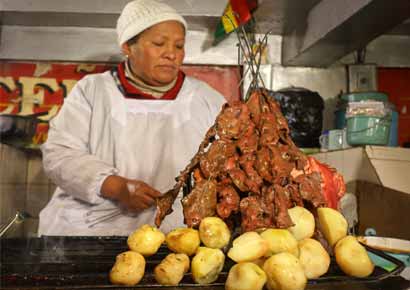
Meat Brochette. To speak of the anticucho is to speak of La Paz night. Thin frets of heart of beef, accompanied by potato and ají of peanuts, are prepared to the heat of the embers, with the aid of oil and vinegar, ingredients that give a characteristic flavor to him.
Chairo
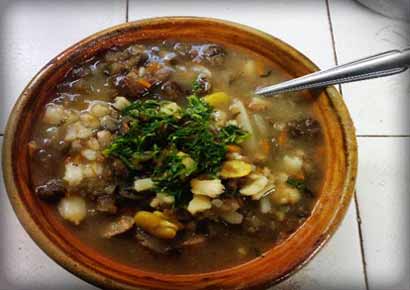 Chairo. Soup dish that is part of the La Paz tradition. It is made with crushed chuño (dehydrated potato), chopped potatoes, white corn, wheat, beef and lamb and chalona. It is accompanied by pieces of fried pork.
Chairo. Soup dish that is part of the La Paz tradition. It is made with crushed chuño (dehydrated potato), chopped potatoes, white corn, wheat, beef and lamb and chalona. It is accompanied by pieces of fried pork.
Fricasé
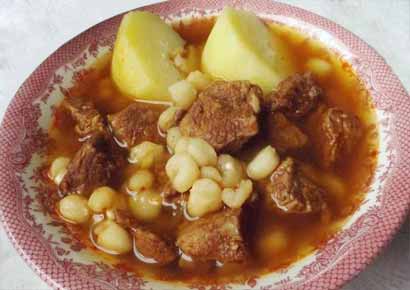 Fricase. Prepared with pork, white corn, chuño, yellow pepper and several condiments, it is a dish that dates from the colonial era. The peculiar and intense flavor of the sautéed meat, turns it into a clear example of paceñización of a Parisian recipe.
Fricase. Prepared with pork, white corn, chuño, yellow pepper and several condiments, it is a dish that dates from the colonial era. The peculiar and intense flavor of the sautéed meat, turns it into a clear example of paceñización of a Parisian recipe.
Cinnamon Ice cream
 Cinnamon ice cream Characterized by the freshness, aroma and flavor of its ingredients: cinnamon, ice, sugar and some secrets of the ice cream makers. This delicacy is accompanied by empanadas stuffed with cheese.
Cinnamon ice cream Characterized by the freshness, aroma and flavor of its ingredients: cinnamon, ice, sugar and some secrets of the ice cream makers. This delicacy is accompanied by empanadas stuffed with cheese.
Api & Buñuelo
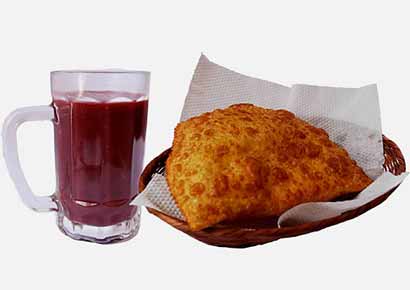 Sweet & Delicious Hot Api. Typical drink of the Andean highlands, made from grains of crushed purple corn mixed with sugar, cloves and cinnamon. Generally Hot, it is served in the morning or at night and is accompanied by fritters, cheese pies or llauchas.
Sweet & Delicious Hot Api. Typical drink of the Andean highlands, made from grains of crushed purple corn mixed with sugar, cloves and cinnamon. Generally Hot, it is served in the morning or at night and is accompanied by fritters, cheese pies or llauchas.
Llauch’a
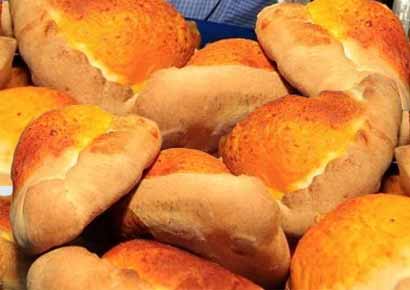 Llauch’a. Empanada elaborated with red pepper, flour, salt, sugar, filled with cheese and, in some occasions, with ulupica and locoto. Next to the marraqueta, it is part of the patrimony of La Paz. Its flavor and shape make this product unique.
Llauch’a. Empanada elaborated with red pepper, flour, salt, sugar, filled with cheese and, in some occasions, with ulupica and locoto. Next to the marraqueta, it is part of the patrimony of La Paz. Its flavor and shape make this product unique.
Mate de Coca
 Mate de coca. It is an infusion of coca leaves, very popular and typical of the Andean regions of Bolivia. It is drunk as a stimulant, energizing and as home relief to altitude sickness; stimulates digestion and relieves tension in the vocal cords, as some of its benefits.
Mate de coca. It is an infusion of coca leaves, very popular and typical of the Andean regions of Bolivia. It is drunk as a stimulant, energizing and as home relief to altitude sickness; stimulates digestion and relieves tension in the vocal cords, as some of its benefits.
Nature
– In Natural Adventures –
Climb the Huayna Potosí
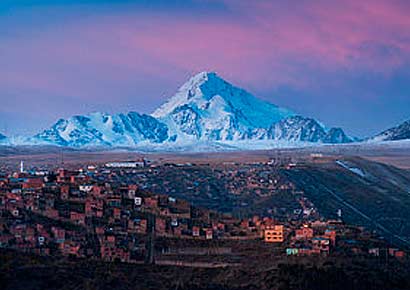 Huayna Potosí 25 kilometers away 30 km north of La Paz, it is one of the snowcapped mountains preferred by the climbers, due to its climbing characteristics and white massifs.
Huayna Potosí 25 kilometers away 30 km north of La Paz, it is one of the snowcapped mountains preferred by the climbers, due to its climbing characteristics and white massifs.
About 1000 climbers make it to the summit every year, and it is said to be an “easy” peak. Base Camp and the obvious entry point for treks in the park is at Zongo Pass 4700 m, on the way to Zongo. Rock Camp at 5130 m offers great views and is the place from where climbers make their ascent of the peak.
Nestled in the Cordillera Real one of the marvelous chains of the Eastern Andes of Bolivia, the snow in question has been virtually conquered by all its fronts, has promoted children and sexagenaires, alone and groups of up to almost a hundred.
The best known route for its ascent begins in the Zongo lagoon, although there are also other alternative routes with different types of difficulty. Coveted by tourists and athletes, the number of visitors to the mountain has increased significantly in recent years.
Although it is not as extensive as the others, it has international popularity. Its monolithic and pyramidal shape, located between the CONDORIRI and CHACALTAYA massifs, can be seen from any place of the Andean zone at an altitude of 6088 meter above sea level. It is considered the easiest 6000-meter above sea level. If you want more info for climb it click here!
Apolobamba Trek
The Apolobamba trek, deep inside the heart of Bolivia, is the ultimate journey to the ends of the Earth.
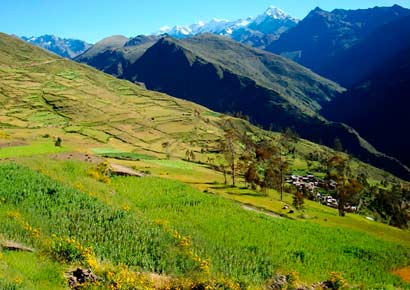
The Cordillera de Apolobamba begins north of Lake Titicaca. It is one of the most beautiful geographical regions of Bolivia. From the high snowy peaks a series of rivers that pour their waters into large arteries of the Amazon basin.
From its heights, almost without any vegetation, the mountain range, in its different levels, is presenting an infinite range of landscapes in which there are natural pastures suitable for the raising of cattle or tree species of fine woods. The most important summits of the Apolobamba Mountain Range are: El Cololo (5,915 masl), Huila Kollo (5,816 masl), Chaupi Orko (6,040 masl).
Here is the town of Curva (located at 3,800 meters above sea level), considered the capital of the Andean people of the Kallawayas, an admirable race that has the role of being traveling doctors with great knowledge of nature and its power. With their remedies and wisdom they walk long journeys to bring aid to the inhabitants of the roof of America.
However, it is an area with a very strong cultural tradition little prepared for tourism, and the services it provides are very few. Its inhabitants continue to preserve their old way of life. Each town holds an annual party, which is usually held during the period from June to September. If you are interested on this trek click here!
Copacabana & Lake Titicaca
On the shores of Lake Titicaca, the highest navigable lake in the world, and tucked between the hills of Calvario and Kesanani is the small town of Copacabana.
Copacabana located 150 km. (3 hours and a half) from the City of La Paz and on the shores of Lake Titicaca is an important tourist and pilgrimage center of Bolivia. A place full of history, legends where you can discover the unforgettable culture and traditions of the towns near Lake Titicaca. It has a beach that despite having cold waters, is ideal for practicing different water sports, as well as being the gateway to the beautiful and sacred Isla del Sol.
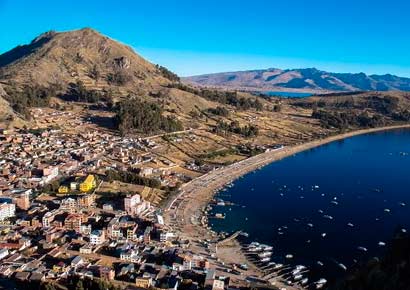
SUN ISLAND
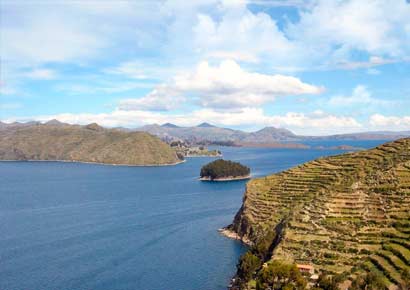
SUN ISLAND
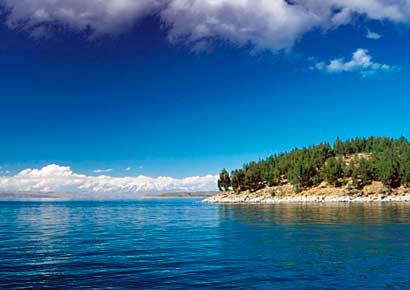
MOON ISLAND
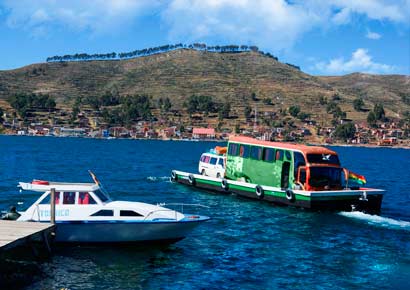
TIQUINA
Trips are made to Copacabana throughout the year, although more often it is visited during February – April, by pilgrims going to Copacabana. There are some travel agencies that organize transfers to Copacabana every day, with guides who will guide you through all of Copacabana and show you the touristic places.
If you are interested to make this trip, click here!
The nice & beautiful Zongo Valley
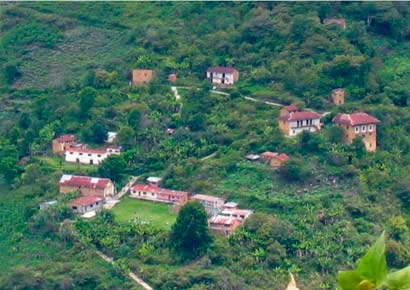
The Zongo Valley is located 76 kilometers north of the City of La Paz; Located between the eastern buttresses of the Cordillera Real de los Andes in Bolivia.
On the route of entry you can enjoy the different ecological levels offered by this region, from a climate of high valley completely frigid at an approximate height of 4200 m.s.m., passing through the eyebrow of the yungueño mountain to the tropical humid forest at 1800 m.s.n.m.
In the descent into the valley, it is possible to observe the scenic beauty of the Zongo river and the tributaries from the melting snow of the Chacaltaya and Huayna Potosí peaks, which are used by the Power Company to provide electricity to La Paz City.
For visitors who come to the area offers various recreational options, such as: hiking to the high areas, lagoons and bofedales that are in its vicinity; mountaineering in the Nevado Huayna Potosí and rafting in the rainy season. For more info about this tour click Here!.
A characteristic feature of the area are the houses made of stone, adobe and thatched roof, exuberant landscapes and a diverse fauna that give a picturesque touch to the area.
It has varied climates and ecological floors with heights ranging from 150 to 6,088 meters above sea level (msnm). Nature observation, landscaping, mountain biking, sport fishing, rafting and trekking, are some of the activities that can be done in the place.
The Moon Valley
Valley of the Moon is a rock formation that is located about 10 kilometers from the center of La Paz City. The Valley of the Moon is a section where erosion has consumed the top of a mountain. Not being solid soil, clay instead of rock, over the centuries the elements have created a somewhat different work of art. It’s like a desert of stalagmites. It is the same as another area, known as the Valley of Souls.
The mountains around La Paz are made of clay. The interesting thing is that this clay contains certain minerals and it seems that they are not the same or their percentage varies from one mountain to another. As consequences the color of the skirts is different, creating very attractive optical illusions. They are mostly of a light color similar to beige or very pale brown. There are also areas that are almost red in color and have dark violet colors.
Walking in the Moon.
Neil Armstrong was the one who baptized this place as Valley of the Moon, in a visit to the city of La Paz in 1969 after witnessing a match between The Strongest and Bolivar, he was preparing to play a game of golf and given the proximity From this place with the golf course, Armstrong saw the similarity that existed with the landscapes of the moon and decided to name it that way.
This place are located in Mallasa, it offers the visitor an incomparable spectacle, due to gray clay rock formations that simulate a lunar landscape. Its trails are characterized by housing different varieties of fauna and flora, typical of the ecological mountain floors. If you are interested in knowing this place click here!
Take your bike and go to the Dangerous Death Road
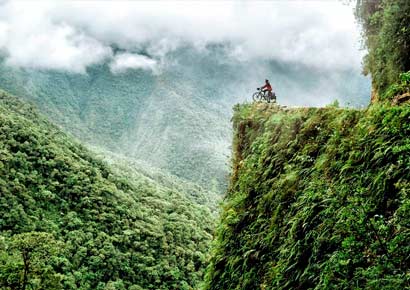
Biking on the Death Road, A popular day trip from La Paz goes to Coroico along the scenic “Death Road” (pictured), regarded as the most dangerous road in the world, due to its notoriously high death rate ☠, this road was cut into the side of the Cordillera Oriental Mountain.
Surrounded by mountainous terrain and terrifying precipices, the winding road stretches 69kms from La Paz to Coroico, connecting the Amazonian rain-forest to the capital city La Paz. If you are interested in this dangerous journey on the road to death, click Here!
Trekking in near of the Muela del Diablo
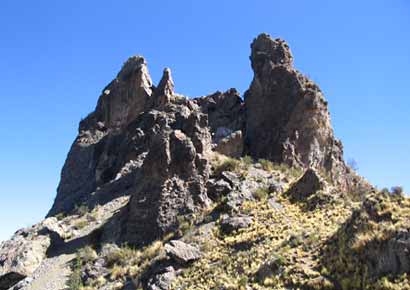 Muela del Diablo. Natural viewpoint located in the macrodistrict of Mallasa. It has a natural monolithic rocky elevation of 150 meters high and shaped like a molar, which stands out in the landscape of the southern area of the city.
Muela del Diablo. Natural viewpoint located in the macrodistrict of Mallasa. It has a natural monolithic rocky elevation of 150 meters high and shaped like a molar, which stands out in the landscape of the southern area of the city.
You have to dedicate a whole day! It is a mountain that you can climb and in which you will see the whole city! From the top! Suitable for tourists who like nature, extreme tourism and photography! highly recommended!
Climbing the Illimani
Many consider it their favorite mountain. The Illimani is the best known summit in Bolivia. It is impossible not to see this summit from anywhere in La Paz, and it is so present at all times that many consider it as a guardian.
Local stories tell myths that it has a magnetic force that attracts airplanes and helicopters to its perdition. Others say that there are mountaineers of more than 100 years frozen, and that there are cold demons hidden among their caves.
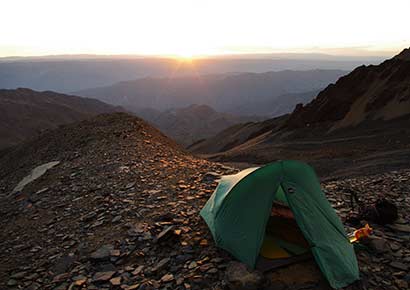
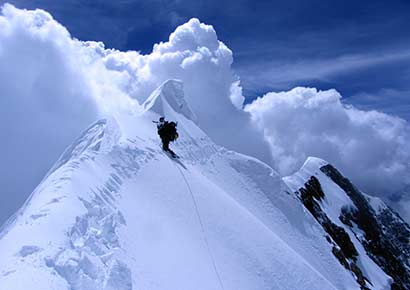
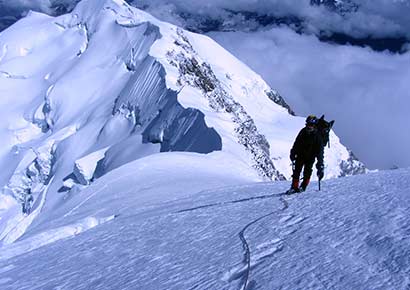
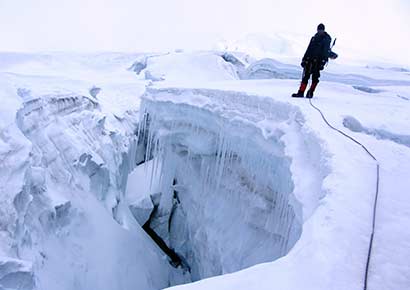
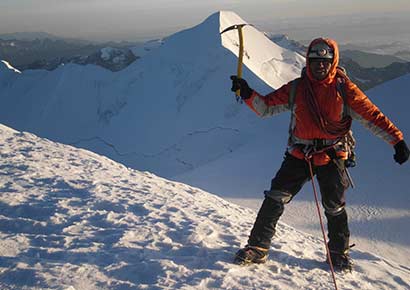
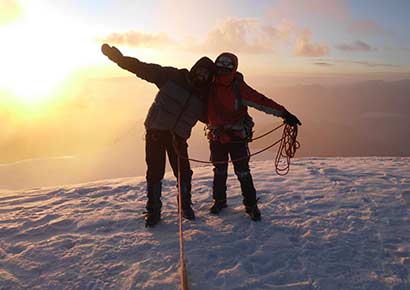
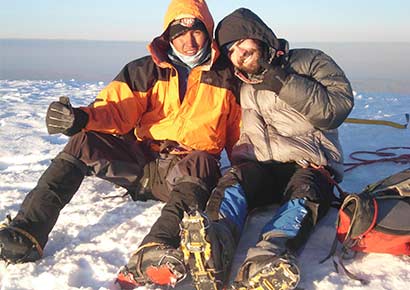
The Illimani produces a strong impact from the city itself, its slender and aesthetic figure dazzles in the distance, numerous artists have dedicated their works, in verse, painting, literature etc, to the guardian and emblem of the city of La Paz.
Mountaineering in particular is a constant challenge at each step, its 9 km of longitudinal peak dotted with peaks and slopes of ice and rock amalgam a mountain difficult and risky for any climber.
For more info, Click here!
Trekking & Climbing Condoriri
It is one of the most spectacular places secretly hidden in the group of mountains of the Cordillera Real, and between the peaks and the ice is the lagoons, which highlights the Chiar Khota lagoon that is at the base of the Condoriri.
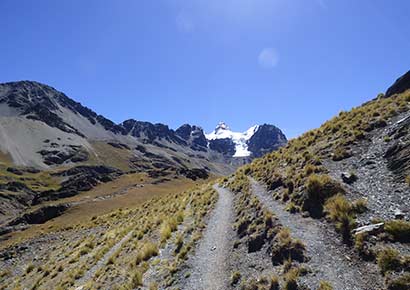
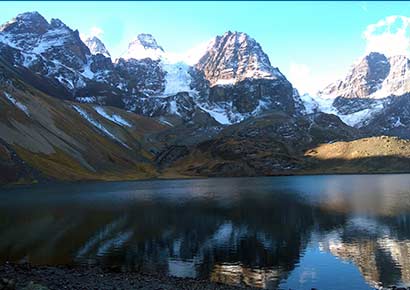
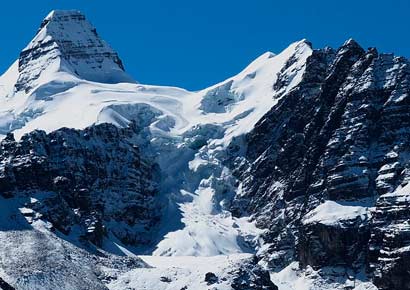
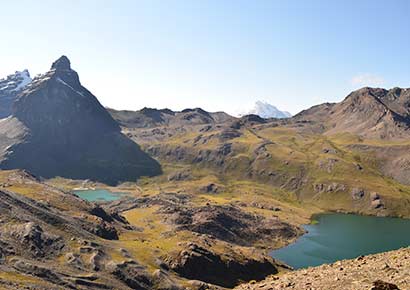
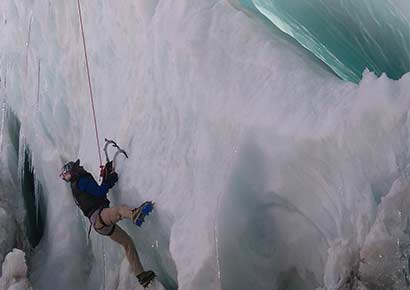
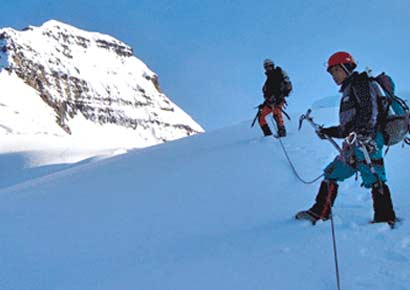
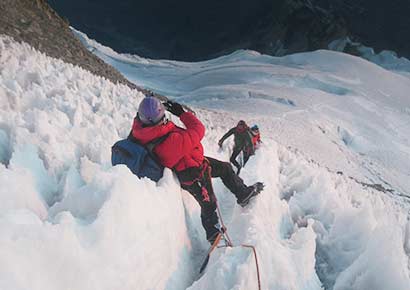
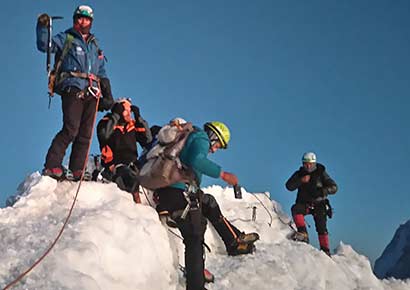
The name of Condoriri is due to its resemblance to the Andean condor which gives it an enormous attraction. Many adventurous travelers make this tour, which is ideal to acclimatize to the altitude, with the aim of ascending to the mountains as the Huayna Potosí, Chacaltaya, as well as to higher mountains that are very demanding, Illimani, Illampu, and above all the Sajama (The highest mountain in Bolivia 6542 meters above sea level).
The place is also ideal for trekking because one climbs to the peak of Austria, where one can appreciate Lake Titicaca, the Nevado Huayna Potosí, and the Nevado del Condoriri peak. Camping in that place manages to find an inner peace that we thought was extinct, forget about civilization and the noise of cities. To contemplate a sunset or the dawn, is something magical. In summary, a place with a lot of potential and located very close to the city of La Paz.
If you want more info about this site Click here!
Visit the ancient Temple of Tiwanaku
Is the most important archaeological site in Bolivia, due to its antiquity, extension and culture. Tiwanaku chronologically dates between 2,000 BC. in its beginnings and 1,000 D.C. in its disappearance, it is one of the cultures that lasted throughout the universal history.
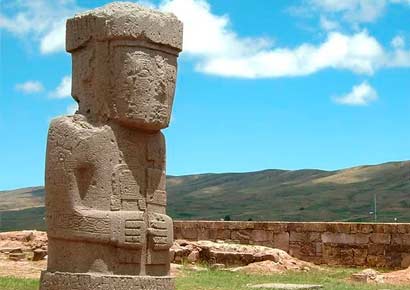
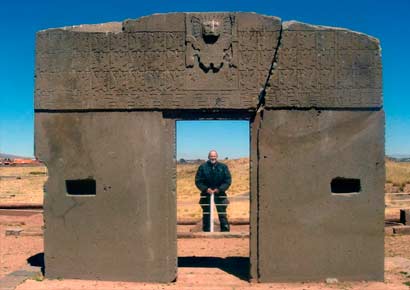
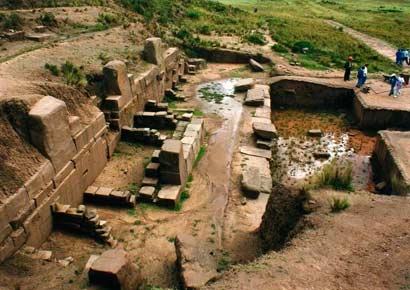
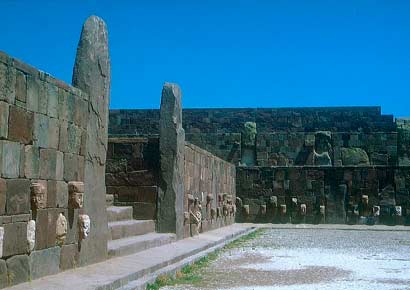
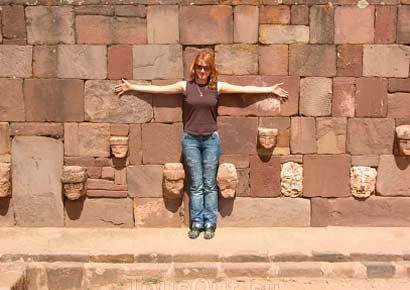
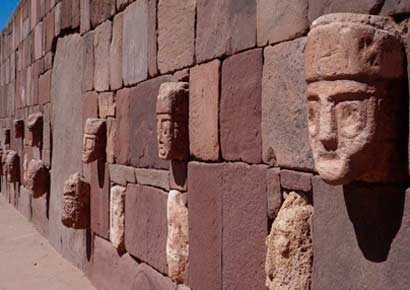
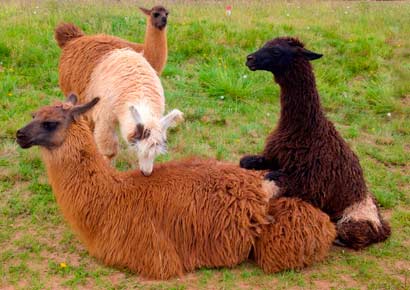
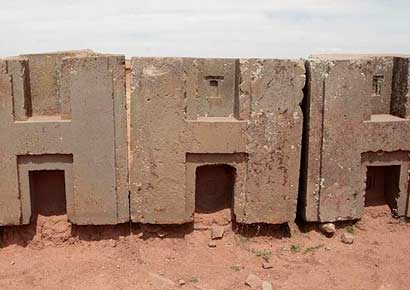
Tiwanaku is located 71 km from the city of La Paz; On the route La Paz – Desaguadero (Frontera Bolivia – Peru), the trip is by paved road and lasts approximately 1 hour and 30 minutes. Tiwanaku is located at an altitude of 3,845 meters above sea level.
The place is incredible, declared a World Heritage Site by Unesco, and it is worth the visit with a guide to know all the details of its rich history, which could not be known simply by being there.
If you are interested in making the trip to the ancient temple of Tiwanaku, Click here!
Culture
– In Culture –
Festival of the Alasitas
Festival of the “Alasitas”. (that in aymara means “buy me”)
Also known as Fiesta de los Miniaturas (party of the miniatures), it is an Aymara tradition held every January 24th. It consists of buying miniatures of everything you want to wish in the year (food, houses, cars, titles, etc.), then make them bless with a yatiri or sorcerer / healer, and offer it to the figure of the Ekeko or God of the Abundance.
The tradition began in 1781 when the Intendant Governor, José Sebastián de Segurola, ordered an annual party in honor of the deity called Ekeko, at a time when the city had been besieged by Tupac Katari.
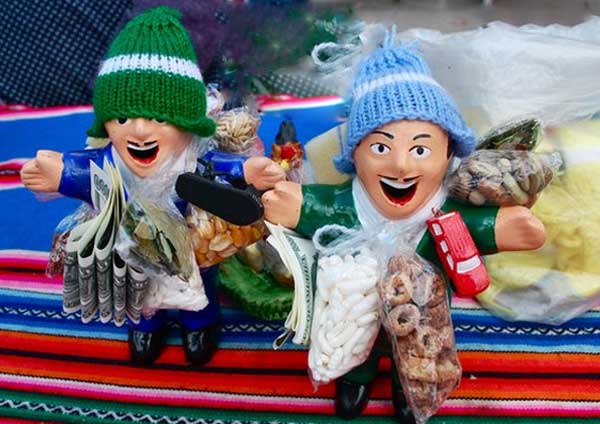
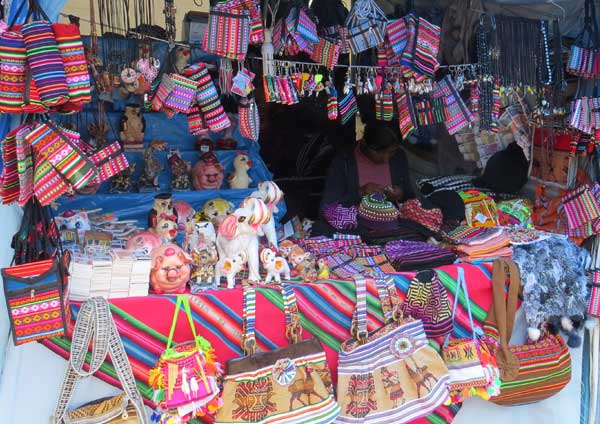
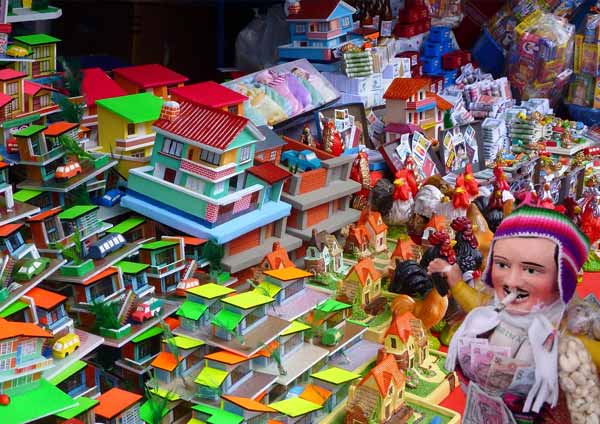
The Ekeko: The dictionary defines it as a supernatural being of popular culture that attracts luck and prosperity to the one who invokes it; It is represented in statuettes carved in various materials, from 10 to 20 cm in height. The Aymara deity Ekeko (god of abundance) is the main object of the fair.
The fair of Alasita, which takes place in the fairgrounds of the Central Urban Park (PUC)
Carnival in La Paz & Oruro
Carnival Paceño. The Carnival in La Paz expresses certain mestizo cultural practices that fuse the Aymara and European cosmovisions, through farándulas, corsos and folkloric entrances. Its central characters are: the cucumber (kind of buffoon that animates the show business) and the ch’uta, a mestizo character who, together with two or more cholas, dances own rhythms of the Carnival.
The Oruro Carnival (World Heritage) is one of the most important carnival celebrations in the world. It gathers thousands of people and a great sample of Andean and popular traditions.
It is a mixture of Spanish and indigenous religious traditions. During the carnival the Virgin of the Socavón is venerated.
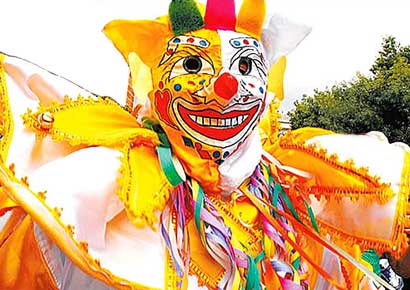
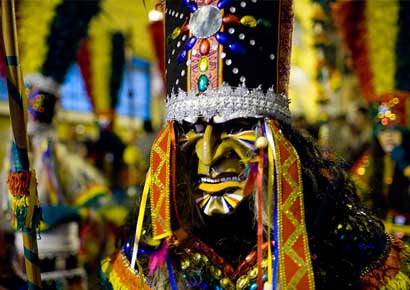
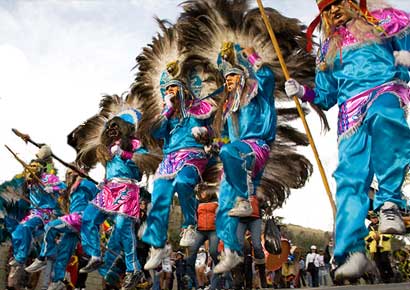
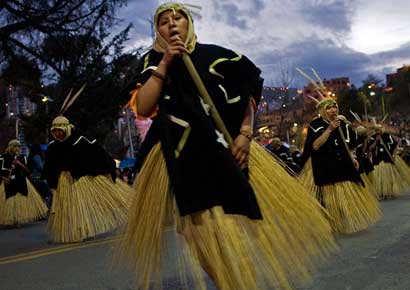
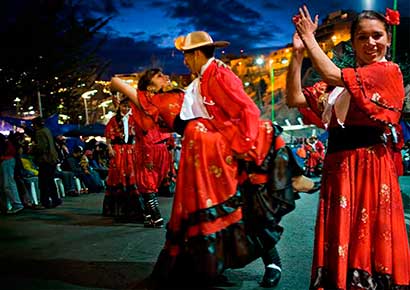
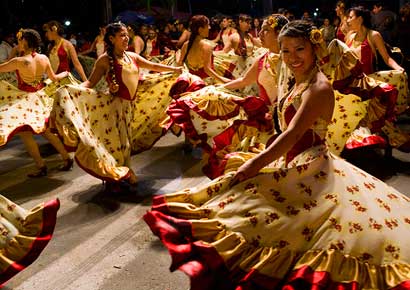
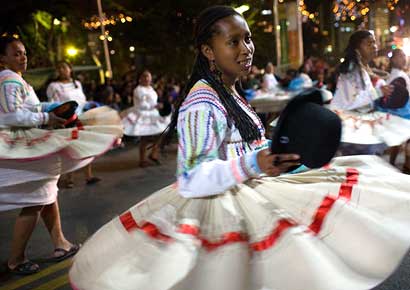
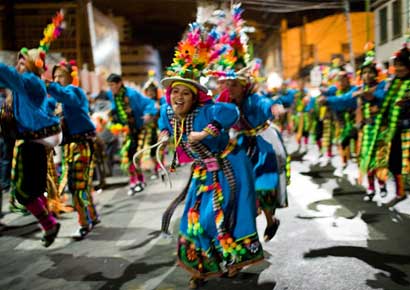
(2020) – February 24 – 25
(2021) – February 15 – 16
(2022) – February 28th – March 1st
(2023) – February 20 – 21
The Lord Jesús of the Great Power
Entrance of the Lord Jesus of the Great Power. Also called Fiesta Mayor de los Andes, it is a religious celebration born in 1923, in the neighborhood of Ch’ijini. In it, more than 35 thousand dancers and musicians, dance to the rhythm of various folkloric rhythms, among which stand out: morenda, diablada, caporales and kullawada, among others. May 26th
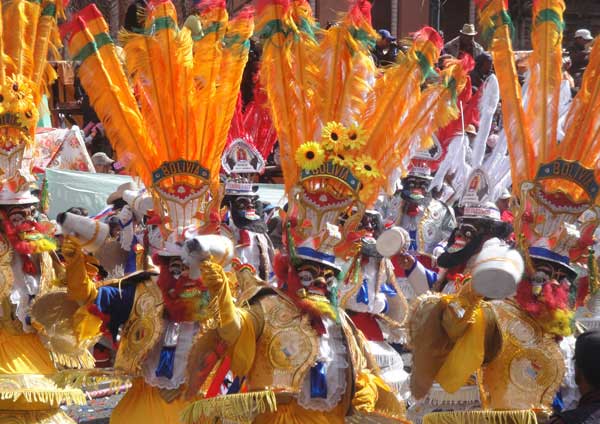
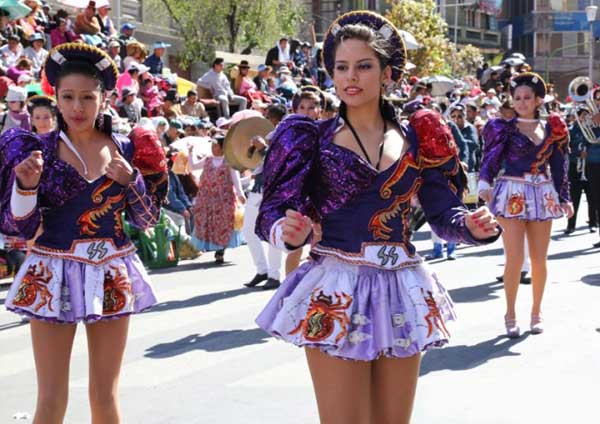
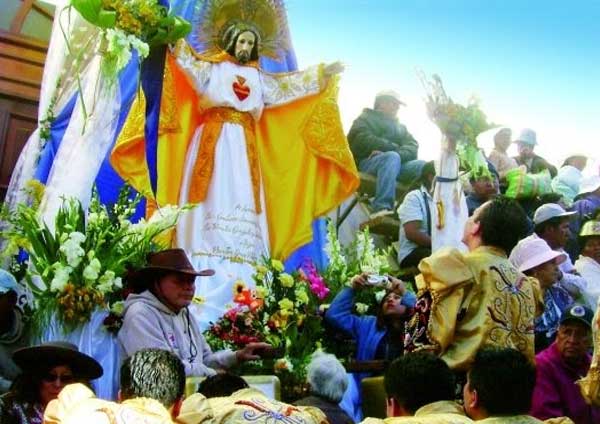
Amazonian Andean New Year
Amazonian Andean New Year. Festivity that takes place every June 21st, coinciding with the beginning of the agricultural cycle. It is celebrated with rituals, tables or altars, entries of native dances, songs and dances, which are the preamble in which the believers raise their hands to receive the first rays of the sun and its energy for start a new cycle.
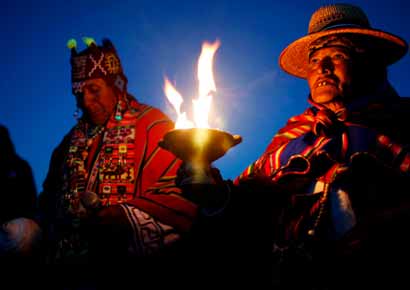
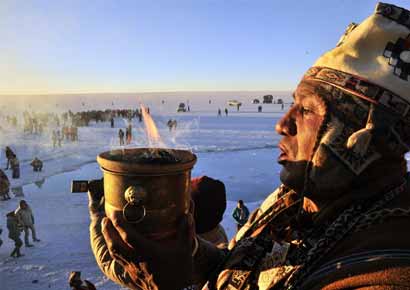
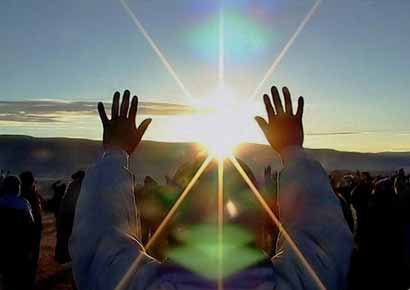
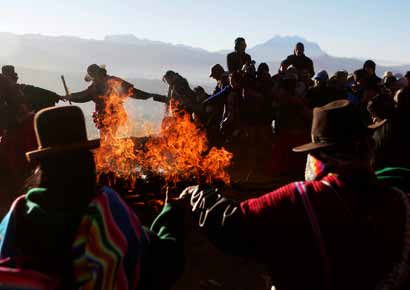
Reading in Coca Leaf
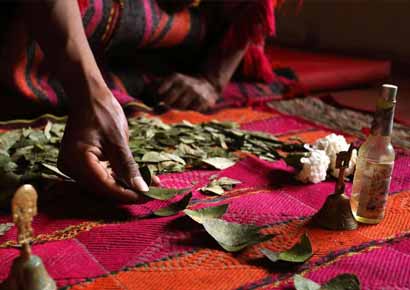 Reading in Coca Leaf. It is a millennial divinatory method and widespread practice throughout Bolivia. It is done on important dates within the worldview Andean crops, such as the beginning of harvests, August; the solstice and festival of the Inti Raymi or King Sun, between June 21 and 24; among others celebrations during the course of the year.
Reading in Coca Leaf. It is a millennial divinatory method and widespread practice throughout Bolivia. It is done on important dates within the worldview Andean crops, such as the beginning of harvests, August; the solstice and festival of the Inti Raymi or King Sun, between June 21 and 24; among others celebrations during the course of the year.
Ritual to the Pachamama
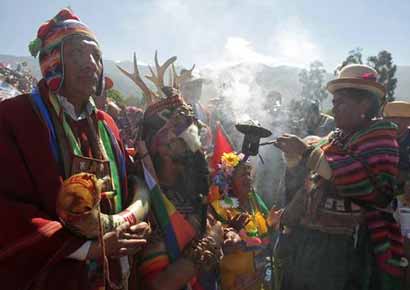 Ritual to the Pachamama. The cult to the Pachamama or Mother Earth is an ancestral custom of the indigenous towns, represented in a sacred offering, denominated k’oa or table. Generally, it is carried out on the first Friday of each month, on Carnival Tuesday and throughout the month of August, in order to request protection and blessing for family, love, work and business.
Ritual to the Pachamama. The cult to the Pachamama or Mother Earth is an ancestral custom of the indigenous towns, represented in a sacred offering, denominated k’oa or table. Generally, it is carried out on the first Friday of each month, on Carnival Tuesday and throughout the month of August, in order to request protection and blessing for family, love, work and business.
All Saints Festival
All Saints Festival. Celebration that extends throughout the Bolivian territory every November 2nd. Its essence is marked by the arrival of the ajayus or souls of the deceased, for whom the mourners install a table or altar that contains a variety of cakes or traditional bakery, such as t’antawawas, sponge cakes and breads, as well as food and drinks preferred – in life – for the deceased.
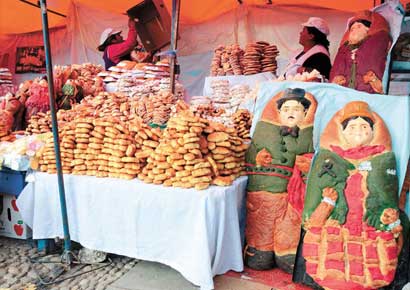
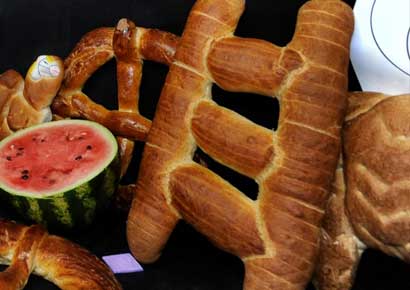
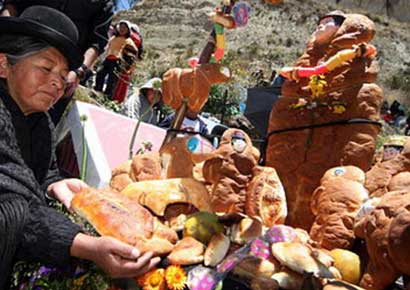
Party of the Ñatitas
Party of the Ñatitas. It is a practice known as the cult and veneration of miraculous skulls, and is directly related to the festival of Todos Santos. Every 8th of November, the ñatitas are put in urns and adorned with lluch’us or hats, hats, cigars and coca, to be taken to the General Cemetery, where a priest blesses them and propitiates a mass in honor of them.
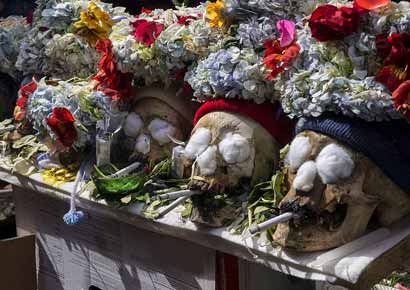
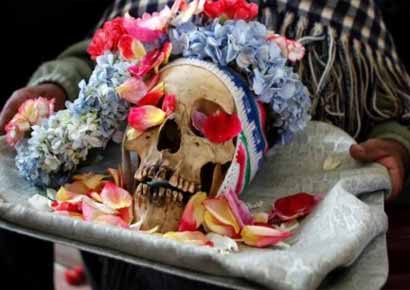
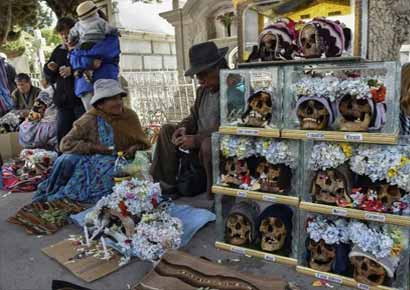
Unique
– in Unique Elements –
Marraqueta
 Marraqueta. Crispy bread – in a unique aesthetic way – prepared with a simple recipe of flour, water, sugar and salt. It represents a symbol of La Paz identity, being a staple food, essential in the breakfast and lunch of the paceños. The year 2006 was declared a cultural and historical heritage of La Paz.
Marraqueta. Crispy bread – in a unique aesthetic way – prepared with a simple recipe of flour, water, sugar and salt. It represents a symbol of La Paz identity, being a staple food, essential in the breakfast and lunch of the paceños. The year 2006 was declared a cultural and historical heritage of La Paz.
Teleférico
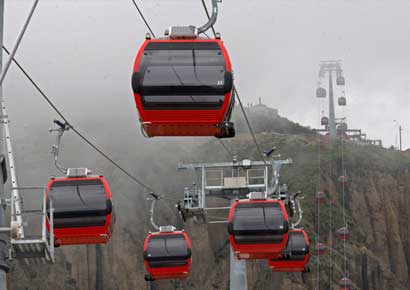 Cableway (Teleférico). Aerial cable transport system linking the cities of La Paz and El Alto. It emerges as an alternative to public transport, given the growing demand of users among these cities. Currently, the Red, Yellow, Orange, Green and Blue lines are in operation; and five new lines are under construction. The White line launched in 2018.
Cableway (Teleférico). Aerial cable transport system linking the cities of La Paz and El Alto. It emerges as an alternative to public transport, given the growing demand of users among these cities. Currently, the Red, Yellow, Orange, Green and Blue lines are in operation; and five new lines are under construction. The White line launched in 2018.
Mirador Killi Killi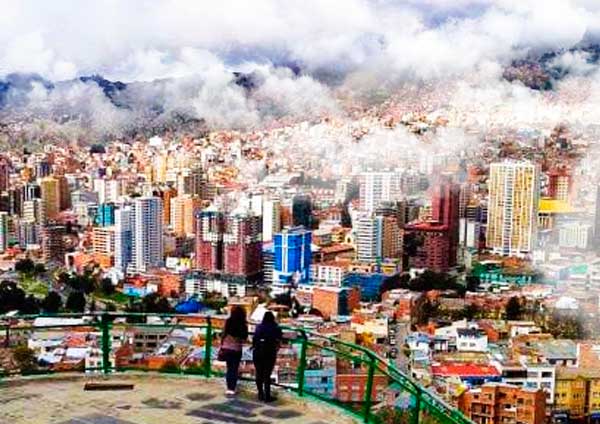
Killi Killi, whose name means “place where the winds are born”, visited by many people who want to taste the panorama of the city.
The place is considered one of the attractions of the city of La Paz because from its top you can admire the changing topography of La Paz city where its inhabitants challenge the slopes and hills by building houses that “hang” touching the sky.
Place dedicated to history
History points out that the legendary indigenous Tupac Katari, organized a siege to the city rejecting the colonial rule of the time – 1781.
There is a painting in the Casa de Murillo Museum, in which you can appreciate that moment, painted by Mariano Florentino Olivares.
La Paz city at Night
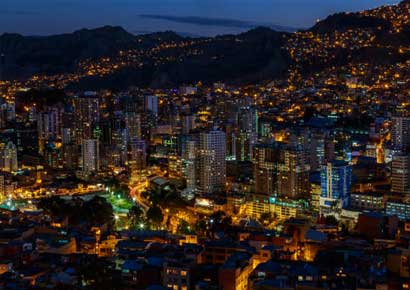 La Paz at night. Undoubtedly, the city seen at night is a different spectacle and this emotion reflects in the nightlife of those who travel it. Different pubs, such as Etno Café, Diesel, La Costilla de Adán, Malegría, Irish Pub, Capotraste and La Chopería, among many others, await their visitors in the traditional areas of Sopocachi, Centro and Sur.
La Paz at night. Undoubtedly, the city seen at night is a different spectacle and this emotion reflects in the nightlife of those who travel it. Different pubs, such as Etno Café, Diesel, La Costilla de Adán, Malegría, Irish Pub, Capotraste and La Chopería, among many others, await their visitors in the traditional areas of Sopocachi, Centro and Sur.
Tourist Puma Katari
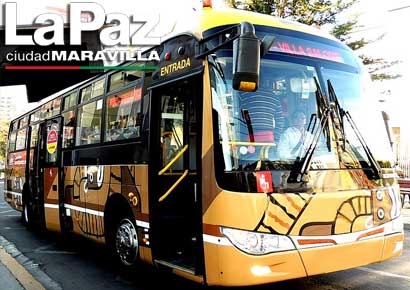 Tourist PumaKatari. If transporting on a PumaKatari bus represents a different alternative for those who live or visit La Paz, the tourist add-on makes this practice an experience in which you get to know the city from other eyes, know its secrets, the history of its neighborhoods and its people. Undoubtedly, an inevitable activity in the city!
Tourist PumaKatari. If transporting on a PumaKatari bus represents a different alternative for those who live or visit La Paz, the tourist add-on makes this practice an experience in which you get to know the city from other eyes, know its secrets, the history of its neighborhoods and its people. Undoubtedly, an inevitable activity in the city!
The Illimani Mountain

Illimani. Located in the municipality of Palca, at 6.462 meters of altitude, it is one of the snowy more imposing that is part of the Cordillera Real.
Considered as the “Guardian of La Paz”, the majesty of this extinct volcano takes care of the passage of those who live and visit the La Paz city.
Few people dare to climb the mountain, and those who reached the top had the opportunity to observe how the rays of the eastern sun come to touch mountains that are more than 75 km away and can contemplate the Titicaca lake that is about 130 km away.
If you are encouraged to do the climbing click here!
Tejada Sorzano Square
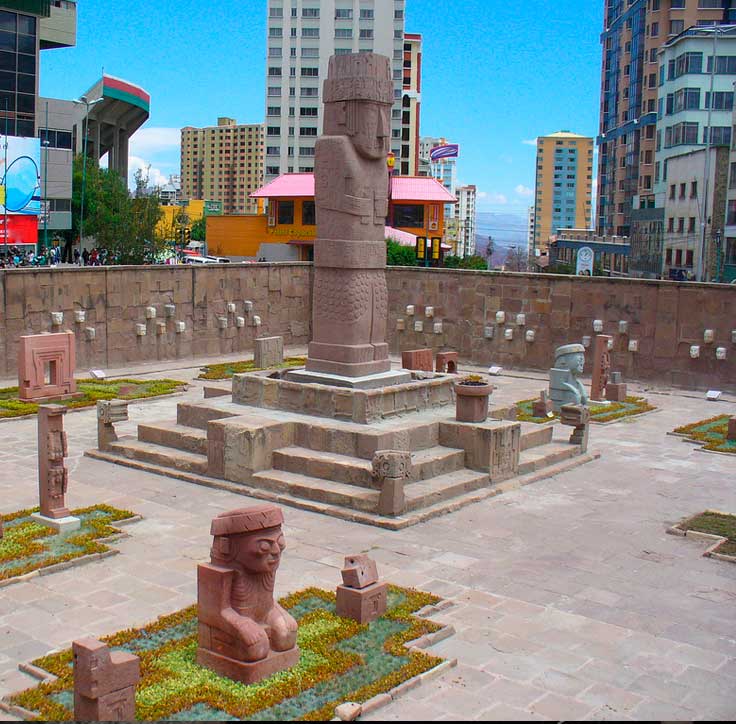 Tejada Sorzano Square. It was built between 1940 and 1943, in order to be a statuary sample of the Tiwanaku culture. Inside, there are embedded monoliths and a replica of Bennett monolith or Pachamama stela. This is a replica of the semi-underground temple of the archaeological complex of tiwanacu which is located at a distance of 70 kilometers from the city of La Paz. For more info about Tiwanaku Click Here
Tejada Sorzano Square. It was built between 1940 and 1943, in order to be a statuary sample of the Tiwanaku culture. Inside, there are embedded monoliths and a replica of Bennett monolith or Pachamama stela. This is a replica of the semi-underground temple of the archaeological complex of tiwanacu which is located at a distance of 70 kilometers from the city of La Paz. For more info about Tiwanaku Click Here
This Square is located near of Hernando Siles is a sports stadium in La Paz. It is the country’s largest sports complex with a capacity of 40.000.
Heritage
– In History –
Murillo Square
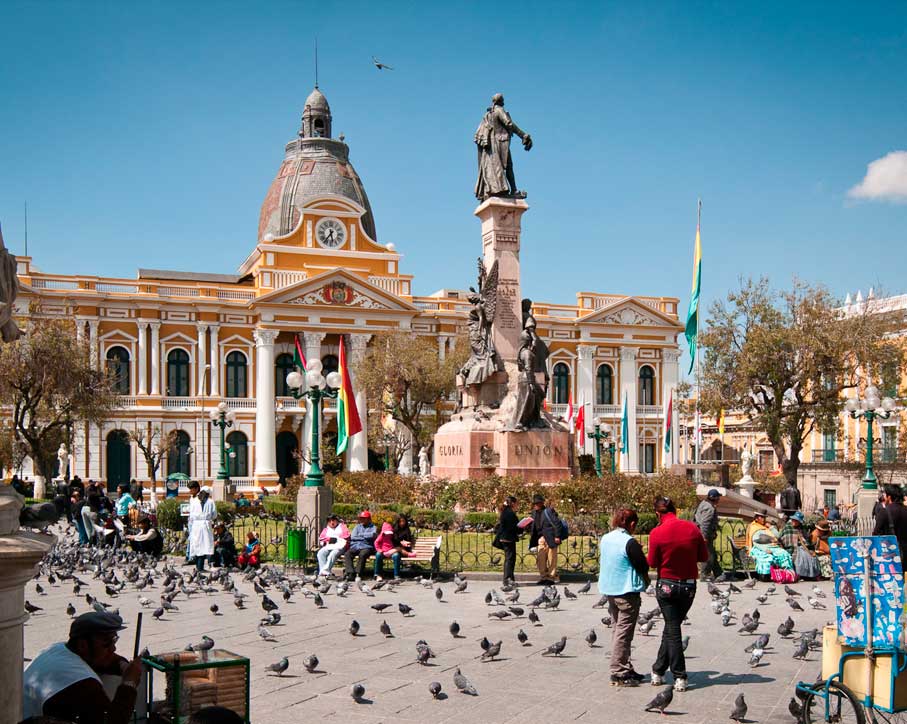 Murillo Square With a baroque architecture built during colonial times, it was the main scene of the birth of the Republic of Bolivia, in 1825. It is known as the “zero kilometer” of the city, in its surroundings is the Government Palace, the Metropolitan Cathedral , the Legislative Palace and the Government of the Department of La Paz, among other buildings.
Murillo Square With a baroque architecture built during colonial times, it was the main scene of the birth of the Republic of Bolivia, in 1825. It is known as the “zero kilometer” of the city, in its surroundings is the Government Palace, the Metropolitan Cathedral , the Legislative Palace and the Government of the Department of La Paz, among other buildings.
Metropolitan Cathedral of Our Lady of La Paz
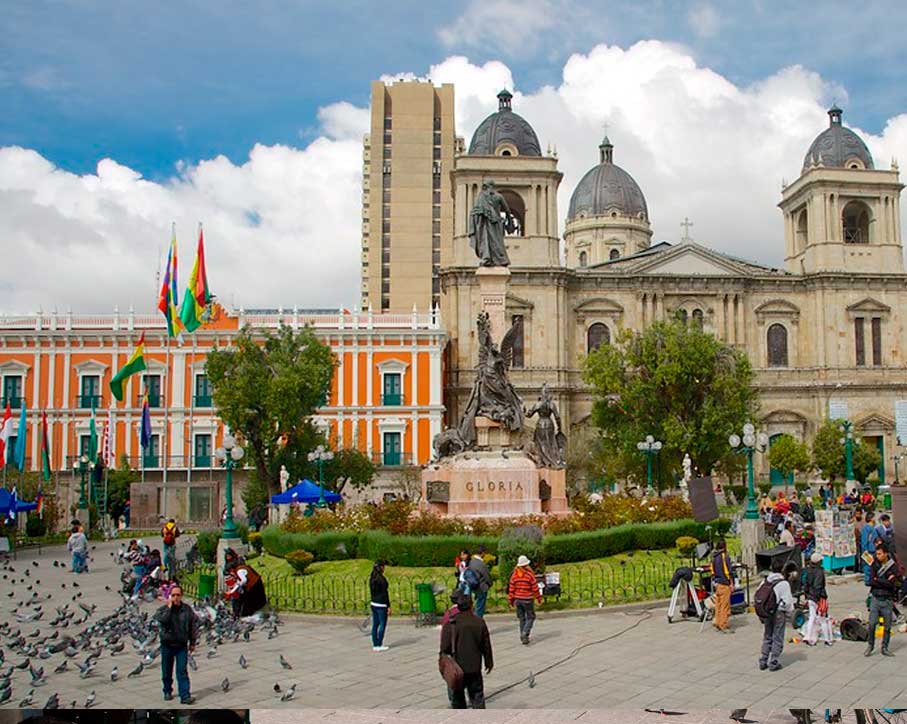 Metropolitan Cathedral of Our Lady of La Paz. Temple built in 1835 and inaugurated in 1925, for the first centenary of the Republic from Bolivia. On the left side there is a chapel where the remains of former president of Bolivia, Andrés de Santa Cruz and Calahumana Location: Plaza Murillo (Comercio Street, corner Ayacucho).
Metropolitan Cathedral of Our Lady of La Paz. Temple built in 1835 and inaugurated in 1925, for the first centenary of the Republic from Bolivia. On the left side there is a chapel where the remains of former president of Bolivia, Andrés de Santa Cruz and Calahumana Location: Plaza Murillo (Comercio Street, corner Ayacucho).
If you want know more about our city, we organize a 4 hours tour City La Paz. Click Here!
The Jaen Street
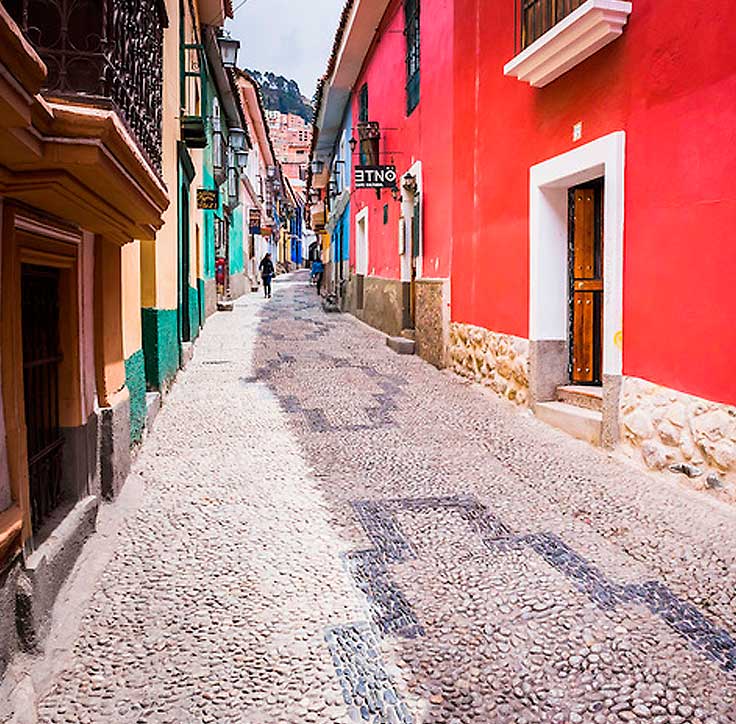 Jaén Street It is one of the most representative streets of the city of La Paz, for its colonial style and degree of conservation. In it, start the circuit of municipal museums (Costumbrista, Litoral, Precious Metals, Casa de Murillo) and the Museum of Musical Instruments of Bolivia, culminating in the corner of the Green Cross. Location: Historical Center of La Paz.
Jaén Street It is one of the most representative streets of the city of La Paz, for its colonial style and degree of conservation. In it, start the circuit of municipal museums (Costumbrista, Litoral, Precious Metals, Casa de Murillo) and the Museum of Musical Instruments of Bolivia, culminating in the corner of the Green Cross. Location: Historical Center of La Paz.
These four small museums are clustered together along La Paz finest colonial street, and can generally be bundled into one visit.
Location in Google Maps
Minor Basilica of San Francisco
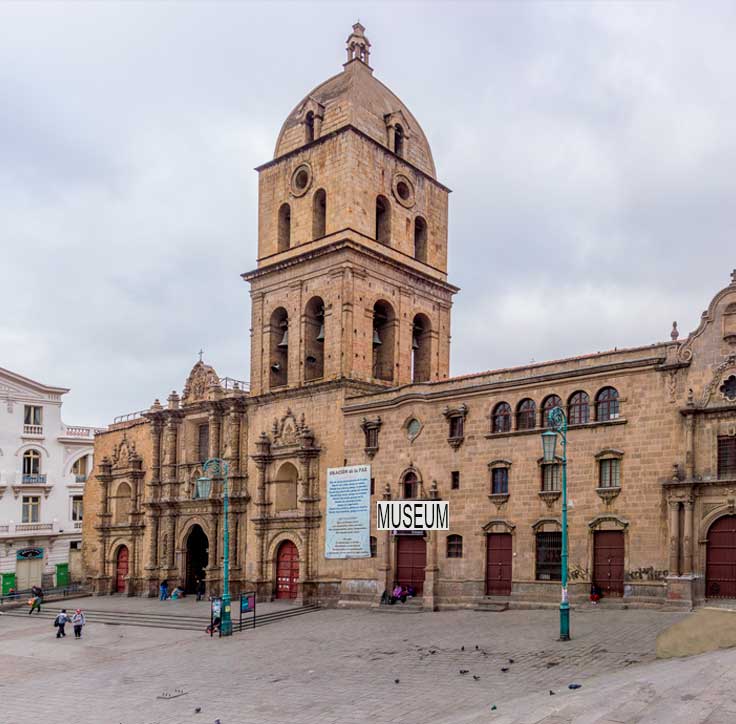 Minor Basilica of San Francisco. It is one of the manifestations of the most important mestizo baroque style in South America. With a façade built in carved stone, this temple consists of a Latin cross plan and a vaulted roof, as well as a large atrium that is integrated into the adjacent public spaces of the Plaza Mayor de San Francisco.
Minor Basilica of San Francisco. It is one of the manifestations of the most important mestizo baroque style in South America. With a façade built in carved stone, this temple consists of a Latin cross plan and a vaulted roof, as well as a large atrium that is integrated into the adjacent public spaces of the Plaza Mayor de San Francisco.
Municipal Theater Alberto Saavedra Pérez
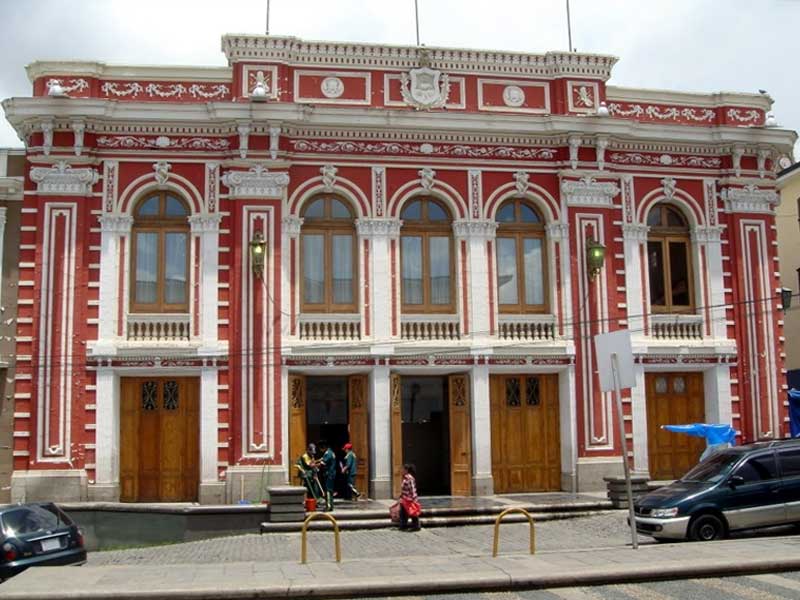 Municipal Theater Alberto Saavedra Pérez. Built between 1834 and 1845, it is one of the oldest theaters in South America. Its architectural style corresponds to the republican period, being the first design similar to that of a Venetian theater of the time.
Municipal Theater Alberto Saavedra Pérez. Built between 1834 and 1845, it is one of the oldest theaters in South America. Its architectural style corresponds to the republican period, being the first design similar to that of a Venetian theater of the time.
It is the main theater of the city of La Paz and the stage for the presentation of recitals and musical concerts, plays, ballet and opera, among other cultural shows. Located on the street Jenaro Sanjinez – Indaburo of the city of La Paz.
Puentes Trillizos
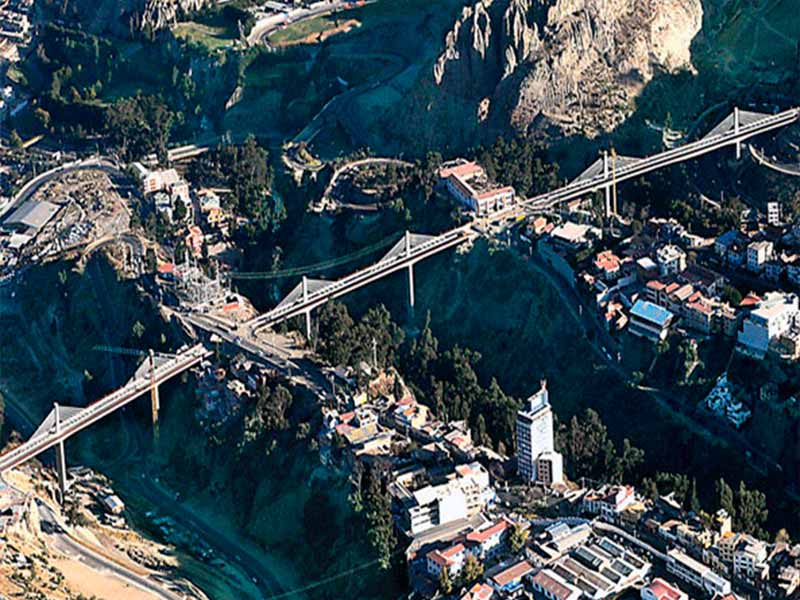 Triplets bridges (Puentes Trillizos) They are considered the largest civil engineering work carried out in the city of La Paz, composed of the bridges: Freedom, Union and Independence. In total, the three bridges have a length 644 m (2.113 ft) of 2000 meters is the link the areas of Alto Obrajes, Miraflores, San Jorge and Sopocachi and were inaugurated on November 28, 2010.
Triplets bridges (Puentes Trillizos) They are considered the largest civil engineering work carried out in the city of La Paz, composed of the bridges: Freedom, Union and Independence. In total, the three bridges have a length 644 m (2.113 ft) of 2000 meters is the link the areas of Alto Obrajes, Miraflores, San Jorge and Sopocachi and were inaugurated on November 28, 2010.
Link the areas of Alto Obrajes, Miraflores, San Jorge and Sopocachi. The names chosen to recognize the bridges are: Independence, Union and Freedom, which can be seen from several points of the city.
General Cementery
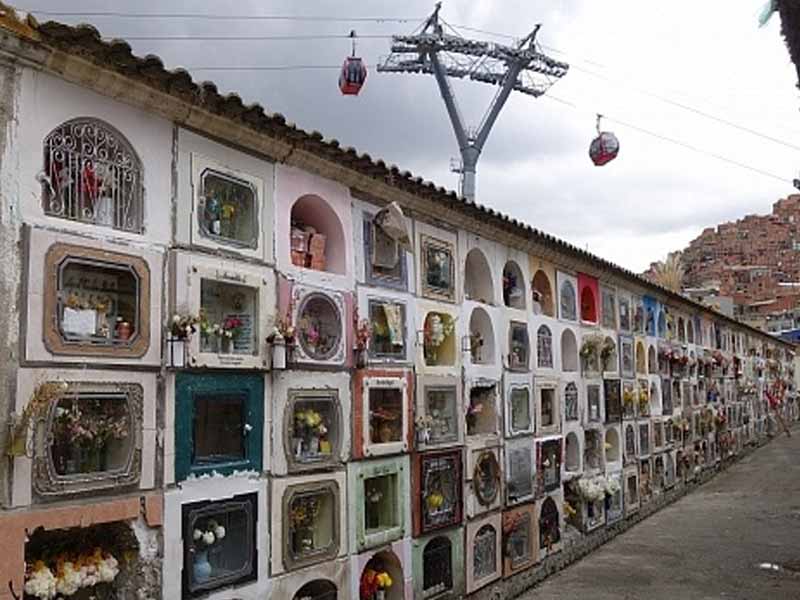 General Cemetery Built in 1831, in the area of El Tejar, it is the first legal pantheon in the city of La Paz, considered one of the 13 most incredible monuments in the world. In its 92,000 square meters, there are pavilions with niches and mausoleums that keep the remains of important Bolivian historical figures, such as ex-presidents, artists, writers, politicians and others.
General Cemetery Built in 1831, in the area of El Tejar, it is the first legal pantheon in the city of La Paz, considered one of the 13 most incredible monuments in the world. In its 92,000 square meters, there are pavilions with niches and mausoleums that keep the remains of important Bolivian historical figures, such as ex-presidents, artists, writers, politicians and others.
Murillo House Museum
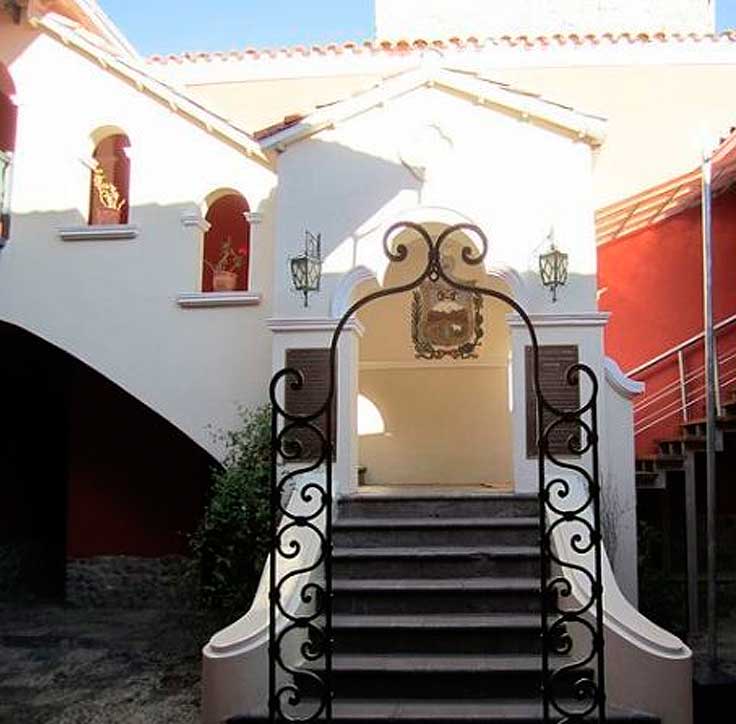 Murillo House Museum . Located on Jaén Street, this museum keeps the memory of the leader of the La Paz revolution of July 1809, Pedro Domingo Murillo. Inside, composed of two floors, there are furniture exhibition rooms, craft rooms, a bedroom, a colonial gallery and an oratory.
Murillo House Museum . Located on Jaén Street, this museum keeps the memory of the leader of the La Paz revolution of July 1809, Pedro Domingo Murillo. Inside, composed of two floors, there are furniture exhibition rooms, craft rooms, a bedroom, a colonial gallery and an oratory.
People
– Our People –
The people are friendly and their important indigenous roots coexist with modernity in a fascinating balance.
Chola Paceña
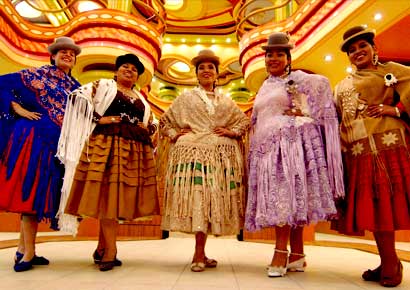 Chola paceña. The identity of the people of La Paz translates into the heritage of miscegenation, represented in the chola paceña – a woman with long braids, an elegant blouse, a pollera and colorful blankets, jewels and a nice borsalino hat – a symbol of strength and in whom lies the economy of his family. For all these reasons, Chola is the cultural and intangible heritage of the city.
Chola paceña. The identity of the people of La Paz translates into the heritage of miscegenation, represented in the chola paceña – a woman with long braids, an elegant blouse, a pollera and colorful blankets, jewels and a nice borsalino hat – a symbol of strength and in whom lies the economy of his family. For all these reasons, Chola is the cultural and intangible heritage of the city.
Zebras
 Zebras The pedestrian crossing, known as the zebra crossing, gave rise to the image of the Cebras Urban Educators, people in charge of taking road education and civic culture tasks to the population through friendly body language.
Zebras The pedestrian crossing, known as the zebra crossing, gave rise to the image of the Cebras Urban Educators, people in charge of taking road education and civic culture tasks to the population through friendly body language.
Classic Paceño
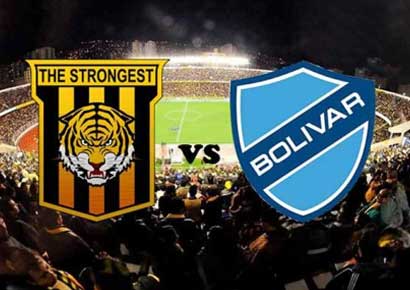 Classic paceño. In Bolivia, soccer is the passion of crowds. The classic paceño is disputed between the two teams with more titles in the history of Bolivian professional football: The Strongest (with 17 cups, since 1950) and Bolívar (with 26 cups, since 1977). Living a classic paceño is undoubtedly an unforgettable experience!
Classic paceño. In Bolivia, soccer is the passion of crowds. The classic paceño is disputed between the two teams with more titles in the history of Bolivian professional football: The Strongest (with 17 cups, since 1950) and Bolívar (with 26 cups, since 1977). Living a classic paceño is undoubtedly an unforgettable experience!

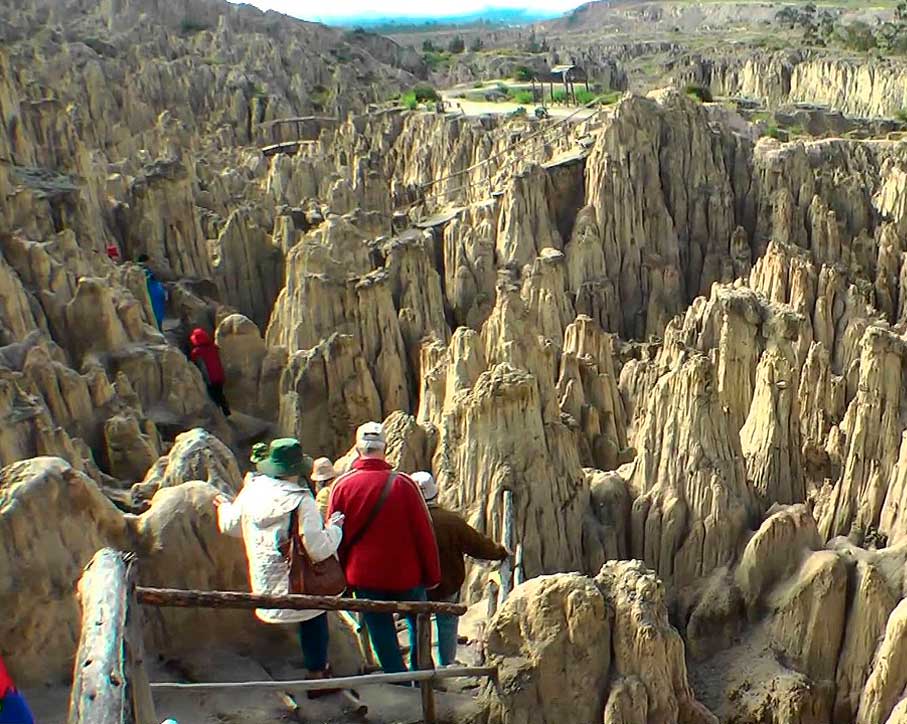

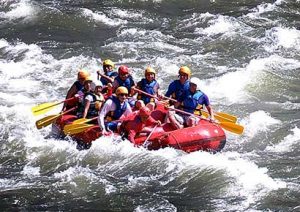
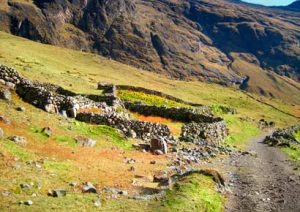
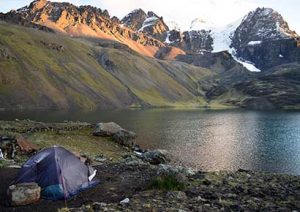
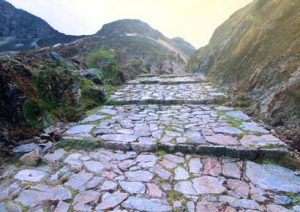
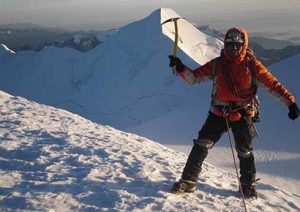
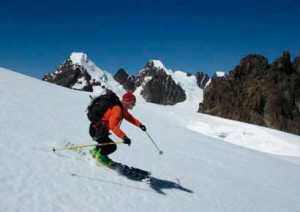
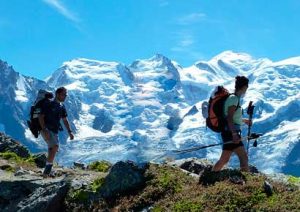
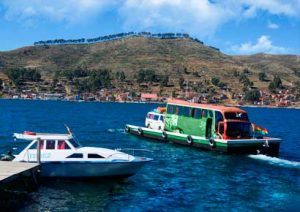
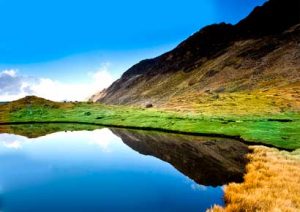
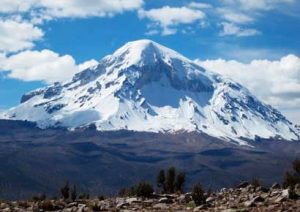
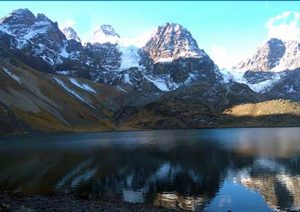
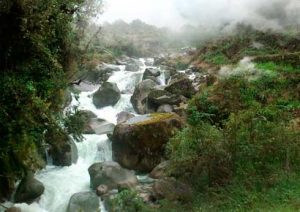
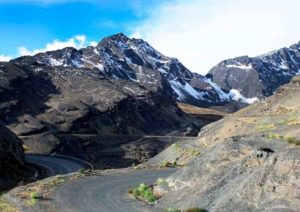
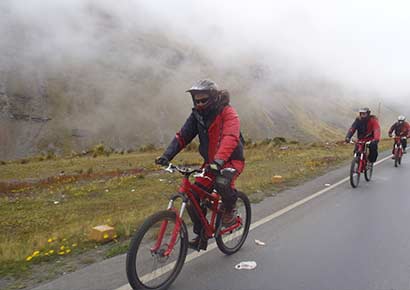
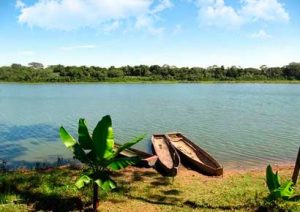
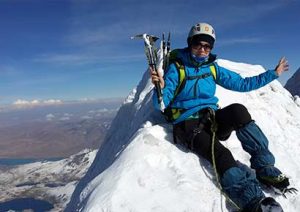
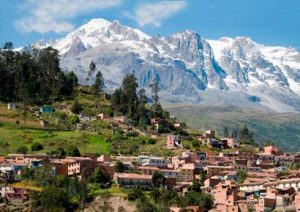
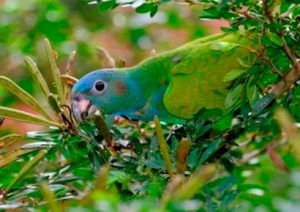
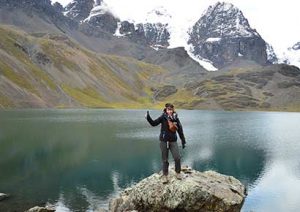
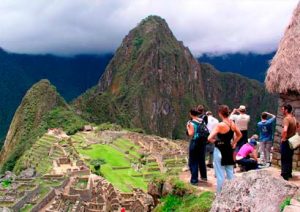
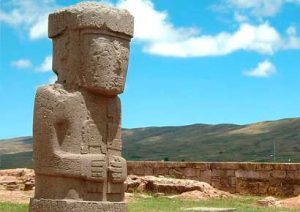
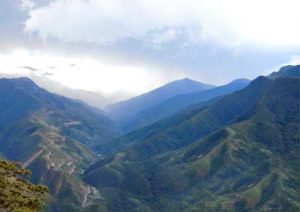
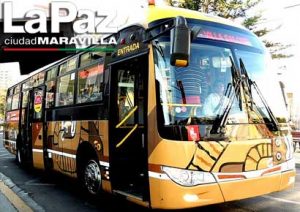
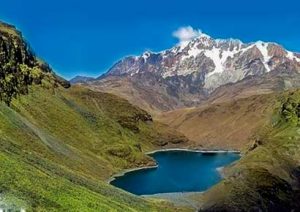
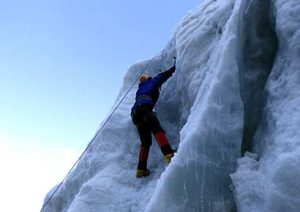
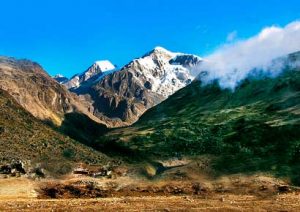
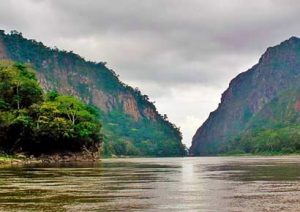
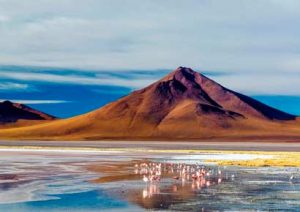
Hello! This is my first visit to your blog! We are a team of volunteers and starting a new project in a community in the same niche. Your blog provided us useful information to work on. You have done a extraordinary job!
Oh my goodness! an incredible article dude. Thanks Nevertheless I am experiencing difficulty with ur rss . Don’t know why Unable to subscribe to it. Is there anyone getting equivalent rss downside? Anyone who is aware of kindly respond. Thnkx
Thanks for this glorious article. Yet another thing to mention is that nearly all digital cameras are available equipped with some sort of zoom lens that enables more or less of a scene to get included through ‘zooming’ in and out. These kinds of changes in concentration length usually are reflected in the viewfinder and on massive display screen right on the back of the actual camera.
With thanks! Valuable information!
With thanks! Valuable information!
Pretty nice post. I just stumbled upon your weblog and wanted to say that I have really enjoyed surfing around your blog posts. In any case I’ll be subscribing to your rss feed and I hope you write again soon!
It?s hard to come by knowledgeable people on this subject, however, you
I got what you mean,saved to fav, very decent site.
I conceive this web site has got some real good information for everyone
With thanks! Valuable information!
With thanks! Valuable information!
some truly interesting information, well written and loosely user pleasant.
Wow, marvelous poker layout! How long have you been blogging for? you made blogging look easy. The overall look of your site is excellent, as well as the content!
so much wonderful information on here, : D.
Hi! Someone in my Myspace group shared this website with us so I came
to check it out. I’m definitely enjoying the information. I’m book-marking
and will be tweeting this to my followers! Wonderful blog and superb design and style.
Like!! I blog frequently and I really thank you for your content. The article has truly peaked my interest.